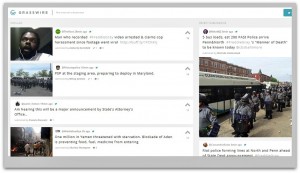With the proliferation of new ways to measure audience behavior on news sites, journalists are in the midst of defining right and wrong ways to use web analytics to set newsrooms strategies.
A few immediate takeaways from a panel at the recent Journalism Interactive Conference, held Friday at the University of Maryland:
Right: Use the numbers to set strategy and build a loyal audience.
Wrong: Ignore the numbers and fail to correct your editorial strategy based on what the data is telling you.
Steve Yelvington, vice president of audience at the Savannah Morning News, joined Susan Mernit, editor and publisher of Oakland Local and project director of Hack the Hood, and Joy Mayer, associate professor at the Missouri School of Journalism, on the panel moderated by Judd Slivka, assistant professor at the Missouri School of Journalism.
(L. to R.) Judd Slivka, University of Missouri; Steve Yelvington, Savannah Morning News; Susan Mernit, Oakland Local, at Journalism Interactive 2014
Related story: “The Pageview is Passé: New Metrics Emerge to Measure Audiences”
The panelists offered a few other major takeaways regarding trends on how metrics influence newsrooms and classrooms:
- Set goals: “Journalists suck at setting goals,” Mayer said. The panelists emphasized that journalists need to work with specific objectives in mind rather than saying they just want everything to be higher or better. “The value of the metric depends on what you are trying to accomplish with it,” Yelvington said.
- Look at multiple metrics: “The beauty of metrics is that you can get a set of numbers, two or more, and make inferences about them,” said Mernit. Journalists have a tendency to get caught in a trap of looking at a single number, rather than a set of numbers that could provide a more accurate picture, the panelists agreed.
- Measure engagement: Mernit highlighted time spent on site and number of returning visitors as two metrics that are key for measuring engagement. The panelists agreed that, while difficult to measure, metrics should be employed to increase impact on the audience.
- The wall is coming down: “I think that we did ourselves a serious disservice by imagining that journalism can proceed without any serious business foundation under it,” Yelvington said. Metrics can inform journalists about what audiences care about, and the audience is best served by journalists who take their needs and wants into consideration, the panel agreed.
- Look at poor performance . . . but be careful: “If we’re going to look at [metrics], it can’t just be to pat ourselves on the back,” Mayer said. It’s important for news sites to look at their content with the lowest number of pageviews and either stop doing those stories or rethink the way they present them, Mayer said. While looking at those stories is important, Yelvington cautioned that “You don’t want to crush someone’s soul.”
- Ask your readers what they like: Mayer said one way to answer questions that standard analytics can’t tell you is to embed a Google survey at the end of story with questions to gauge reader reactions on a story.
- Think outside the box: “The real value of analytics comes from not thinking like a journalist,” Mayer said. Analytics allow journalists to see how the audience gets to the site and how they act once they get there, which can give them information about the overall audience experience. Analytics allow journalists to take a look at this big-picture perspective.







Leave a Comment